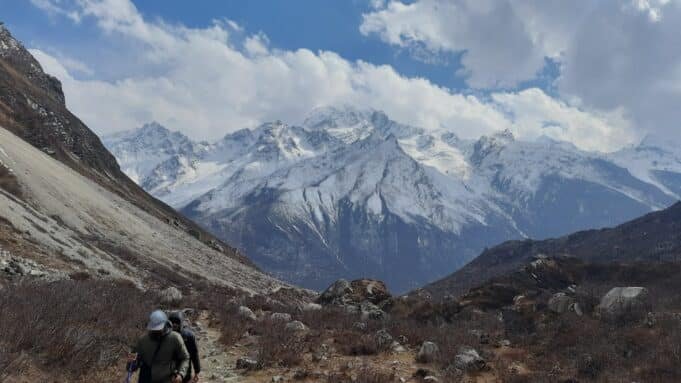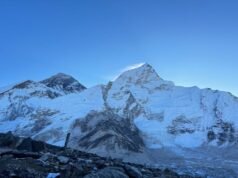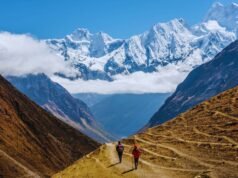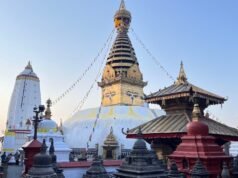If you are looking for a short yet adventurous Himalayan journey, this 5 Days Langtang Valley Trek is all you need. Just north of Kathmandu, Langtang offers breathtaking mountain views, Tamang culture, and serene landscapes, all packed into a trek you can complete within a week. It’s the perfect choice for those who want a Himalayan experience without spending weeks on the trail.
Why Choose the Langtang Valley Trek?
- Close to Kathmandu – only a 7-hour drive to the starting point.
- Moderate Difficulty – doable for beginners with average fitness.
- Rich Culture – meet the Tamang and Tibetan-influenced communities.
- Stunning Views – Langtang Lirung (7,227m), Gangchempo, and Dorje Lakpa.
- Wildlife – red pandas, Himalayan monals, and even snow leopards in the Langtang National Park.
Suggested Itinerary (5 Days)
Day 1: Kathmandu – Syabrubesi (1,550m)
- 7–8 hour drive from Kathmandu.
- Roads are winding but scenic, passing through Trishuli and Dhunche.
- Stay overnight in Syabrubesi.
Day 2: Syabrubesi – Lama Hotel (2,380m)
- Trek time: 6–7 hours.
- Trails pass through forests of oak, rhododendron, and bamboo.
- Cross several suspension bridges.
- Stay in Lama Hotel, a small village surrounded by greenery.
Day 3: Lama Hotel – Langtang Village (3,430m)
- Trek time: 6 hours.
- Gradual climb with great mountain views.
- Pass Ghodatabela and meadows with yaks grazing.
- Reach Langtang Village, rebuilt after the 2015 earthquake.
Day 4: Langtang Village – Kyanjin Gompa (3,870m)
- Trek time: 3–4 hours.
- Shorter but very rewarding day.
- Explore the Kyanjin Monastery, yak cheese factory, and enjoy wide mountain panoramas.
- Optional hike to Kyanjin Ri (4,773m) for a spectacular sunrise/sunset view.
Day 5: Kyanjin Gompa – Syabrubesi – Drive back to Kathmandu
- Trek down to Syabrubesi (7–8 hours).
- Drive back to Kathmandu the same evening or the next day.
Trek Cost Breakdown for 5 days Langtang valley trek
- Permit Fees:
- Langtang National Park Entry: NPR 3,000 (foreigners) / NPR 1,500 (SAARC)
- TIMS Card: NPR 2,000
- Accommodation: $5–10/night (basic tea houses).
- Meals: $15–25/day depending on altitude.
- Transport: Kathmandu to Syabrubesi bus/jeep: $10–30.
- Guide & Porter (optional but recommended): Guide $25–30/day, Porter $20–25/day.
Trek Difficulty Factors
The Langtang Valley Trek is considered a moderate trek in Nepal. It’s neither too easy nor too extreme, making it suitable for both beginners (with preparation) and experienced trekkers.
1. Trail Conditions
- Mostly well-marked trekking trails.
- Includes forests, stone steps, suspension bridges, and some steep climbs.
- No technical climbing or ropes needed.
2. Daily Walking Hours
- Average 5–7 hours of trekking per day.
- Some days (like Lama Hotel → Langtang Village) can feel long due to steady uphill climbs.
3. Altitude
- Highest overnight stay: Kyanjin Gompa (3,870m).
- Optional side hike: Kyanjin Ri (4,773m).
- The risk of altitude sickness is moderate hydration and gradual pace are important.
4. Fitness Level
- Requires basic physical fitness: stamina for long walks, ability to handle uphill climbs.
- Previous trekking experience is helpful but not mandatory.
5. Weather & Seasons
- Spring (Mar–May) and Autumn (Sep–Nov) = best conditions.
- Winter = cold, snow may make trails harder.
- Monsoon = leeches, slippery trails, risk of landslides.
Best Seasons to Go for Langtang Valley Trek
Spring (March – May)
- Why it’s best: Forests come alive with blooming rhododendrons, orchids, and lush greenery.
- Weather: Mild temperatures, warm days, and chilly nights.
- Views: Clear skies, excellent visibility of Langtang Lirung and surrounding peaks.
- Crowds: Moderate to high (popular season).
Autumn (September – November)
- Why it’s best: The most popular season for trekking in Nepal. Stable weather, dry trails, and clear air after the monsoon.
- Weather: Crisp mornings, sunny days, cold nights.
- Views: Some of the best mountain panoramas of the year.
- Crowds: High, especially in October.
Winter (December – February)
- Why trek then: Fewer trekkers, peaceful trails, and snow-covered landscapes.
- Weather: Very cold, especially at higher altitudes. Nights can drop well below freezing.
- Views: Crystal-clear skies but short daylight hours.
- Note: Some lodges may be closed, and heavy snow can block trails.
Monsoon (June – August)
- Why avoid: Heavy rainfall, slippery trails, and risk of landslides.
- Weather: Warm but very wet, with leeches in lower forests.
- Views: Clouds often block mountains.
- Bonus: Fewer trekkers and lush green valleys, but not ideal for most travellers.
Packing List for Langtang Valley Trek
The Langtang region can get chilly, especially at night above 3,000m. Packing light but smart is key because you’ll be carrying (or your porter will carry) everything.
Base Layers (for comfort & warmth)
- 2–3 moisture-wicking T-shirts (synthetic/merino wool)
- 1–2 thermal base layers (top + bottom)
- 2 pairs of trekking trousers (convertible ones are best)
- 1 pair of trekking shorts
Insulation Layer
- Fleece jacket or light down jacket
- Woollen sweater (optional, for evenings)
Outer Layer
- Waterproof & windproof jacket (Gore-Tex or similar)
- Waterproof trekking pants
Head & Hands
- Warm beanie/hat
- Sun hat or cap
- Neck gaiter or buff
- Lightweight gloves + insulated gloves
Footwear
- Sturdy trekking boots (broken in, waterproof recommended)
- 2–3 pairs of hiking socks (wool/synthetic blend)
- 1–2 pairs of liner socks (to prevent blisters)
- Lightweight sandals or slippers (for teahouses)
Gear & Accessories
- Backpack (30–40L for personal use)
- Duffel bag (if you hire a porter)
- Sleeping bag (rated to –10°C to –15°C; teahouses provide blankets but extra warmth is great)
- Trekking poles (optional but highly recommended for steep climbs/descents)
- Headlamp with extra batteries
- Sunglasses (UV protection, polarized if possible)
- Reusable water bottle (at least 1L) or hydration bladder
- Water purification tablets or filter (safe water isn’t always available)
- Quick-dry towel
Personal Items
- Passport + permits (TIMS & Langtang National Park)
- Cash (ATMs are not available on the trail; carry NPR for food, tea houses, Wi-Fi, charging)
- Snacks (energy bars, trail mix, chocolate)
- Notebook/pen (optional for journaling)
Health & Toiletries
- Personal first-aid kit (band-aids, painkillers, antiseptic, blister pads)
- Medication (Diamox for altitude, if needed; consult your doctor)
- Sunscreen (SPF 40+)
- Lip balm (SPF protection)
- Hand sanitizer
- Wet wipes & toilet paper
- Toothbrush, toothpaste, soap (biodegradable preferred)
- Small moisturizer (air is dry at altitude)
Electronics
- Phone + charger
- Power bank (10,000mAh or more; charging costs extra in tea houses)
- Camera (optional)
- Travel adapter (Nepal uses Type C/D plugs, 230V supply)
FAQs: 5 Days Langtang Valley Trek
1. How difficult is the Langtang Valley Trek?
It’s moderate. No technical climbing required, but you’ll be trekking 5–7 hours daily.
2. Do I need a guide?
Not compulsory, but a guide enhances safety and cultural experience. Porters can help carry loads.
3. What is the highest point of this trek?
Kyanjin Ri (4,773m) if you do the side trip, otherwise Kyanjin Gompa (3,870m).
4. Can beginners do this trek?
Yes, with basic fitness and preparation.
5. Is altitude sickness a concern?
Less likely in 5 days, but possible. Stay hydrated, ascend gradually, and rest if needed.
6. Can I charge my phone/camera on the trek?
Yes, but charging costs extra ($1–3 per device) in tea houses. Carry a power bank.
7. Is Wi-Fi available?
Yes, in some tea houses, but it’s slow and may cost extra.
8. What’s the food like?
Dal Bhat is the staple. You’ll also find noodles, soups, pancakes, eggs, and tea.
9. How crowded is the Langtang trek?
Less crowded compared to Everest and Annapurna, but popular in peak seasons.
10. What makes Langtang Valley special?
Close proximity to Kathmandu, Tibetan-influenced culture, glaciers, and dramatic alpine scenery.















